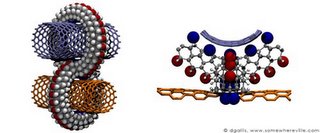Cracking the Code of Visual Processing
Neuroscientists Break Code on Sight
Exploring those developments in technology that will radically alter human existence in the near future. Implications of smarter-than-human artificial intelligence, nanotechnology, biotechnology, and the impending Singularity.


Although a few definitions exists, the Singularity is most accurately defined as the point in time ushered in by the development of recursively self-improving smarter-than-human intelligence. This could be achieved either through the augmentation of a human brain, mind uploading, or the development of Seed Artificial Intelligence. In any case, this development will create a discontinuity in human history so abrupt and profound that our existence will forever be radically altered.
The term Singularity was derived from the concept in physics where a singularity represents the center of a black hole. At this point in space all of our physical models break down as the density of the black hole approaches infinity. Similarly, the technological Singularity represents a point at which our models of the future break down and we become unable to extrapolate beyond its event horizon. Just as light cannot escape beyond the event horizon, or "surface", of a black hole, once we pass the event horizon of the Singularity, there will be no going back.
The Singularity has greater significance than any event prior to it because it represents transcending a limitation that has existed on our planet, and possibly the entire universe, since its origins. Although humans have evolved far enough to develop a self-reflective level of intelligence, they have been restricted by that same level of intelligence for the past 50,000 years of their existence. Despite its successes, human level intelligence also has many short comings. For one, human minds are unable to access their underlying "source code" and thus cannot make modifications or improvements. Also, they very limited in their ability to absorb information, retain information, perform rapid calculations, communicate information to other minds, and think on very complex or abstract levels.
One reason for these limitations is due to the restrictive hardware of the human mind. While there exist hundreds of billions of neurons each with thousands of connections, each neuron is only able to operate at a lowly 200 Hz speed. And so the serial speed of the human mind remains tens of millions times slower than that of the modern computer. By transferring a biological mind to a non-biological substrate, while retaining massive parallelism, we would achieve enormous increases in thinking speed. However, simply thinking trillions of times faster is not enough, we also need a mind to be able to think smarter.
And so the second limitation of the human mind is on the software level. The blind forces of evolution produced a software focused on enabling the survival of genes within competitive environments. There was no forethought or planning, whatever produced immediate benefit was introduced to the gene pool. Furthermore, evolution could not scrap a design and start fresh, it could only work with what was already available. So the human mind is a conglomeration of specialized modules added throughout its evolutionary history. This specialized intelligence represents one in a vast space of possible intelligences. And while it has proven effective in out-smarting predators and competing for food and mates, it falls short on many other levels. For instance, the human brain is prone to utilize certain heuristics and biases that produce falicous ideas and irrational decisions.
If we were to redesign the human brain we could remove all of its failings and weaknesses while adding new layers of cognition to create a type of general intelligence. The strongest advantage of this general intelligence would be its ability to examine its own internal workings or "source code" and make improvements as it sees fit. This recursively self-improving mind could then create an even more intelligent mind, thus generating a near infinite positive feedback loop. Within a very short period of time, this intelligence could reach levels beyond human comprehension, thus generating the "spike" of the Singularity.
"From the human point of view this change will be a throwing away of all the previous rules, perhaps in the blink of an eye, an exponential runaway beyond any hope of control. Developments that before were thought might only happen in "a million years" (if ever) will likely happen in the next century." Vernor Vinge
And so why would the Singularity be desirable for humanity?
The development of smarter-than-human intelligence would provide greater benefit to humanity than all other developments combined. This is because a "hard" problem for humanity will suddenly become trivial when a level of intelligence of the appropriate magnitude is applied to it. Problems of limited resources, pollution, war, destruction, needless suffering, poverty, starvation, disease, aging, and death could be solved in a single insight. Humans could become smarter, healthier, happier, and gain the potential for unlimited growth, exploration, understanding, and advancement. The Singularity represents humanity's greatest chance to achieve the Apotheosis, the best of all possible worlds.